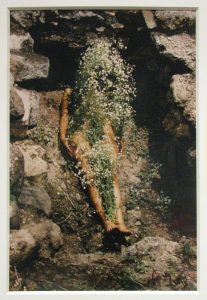Ana Mendieta’s Environmental Art and the Harmonious Intersection of Humanity and Nature
Paola Castillo
Ana Mendieta’s art plays with a variety of themes including feminism, spirituality, and cultural identity.

This portfolio highlights Mendieta’s ideas about the relationship between humans and nature, encouraging audiences to consider humanity’s impact on the environment. One of her most popular works, her “Silueta Series”, brings rise to a sense of respect toward nature. Using organic materials, Mendieta’s art delivers a message about human’s imposition on nature as opposed to an integration with nature. Mendieta’s environmental art is iconic in its consideration of our existence within the larger ecological context.

Environmental art is a broad range of artistic practices that address ecological engagement or issues, promoting awareness about environmental concerns. In my review, I found that Mendieta’s art addresses these themes: harmony with the environment & humanistic temporality in nature. Harmony with the environment reflects a value placed on a balanced and respectful relationship with nature. Artists who examine this theme usually explore the sentiments of interconnectedness and coexistence situated in the ecosystem. Humanistic temporality in nature expresses how the human experience intersects with the lifecycles and cyclical processes of nature. Furthermore, this theme aims to build a personal connection between the audience and the environment by considering our perceptions of time.

Ana Mendieta lived from 1948 to 1985 as a Cuban-American artist who was known for her performances and her art. She had a deep-rooted connection to nature and strong feminist ideologies that influenced her artistic practices. The “Silueta Series” was created between 1973 and 1980, consisting of earthly body sculptures and performances. In an interview, Mendieta spoke about her use of these silhouettes to highlight her symbiotic relationship with the land. The creation of this work helped the artist explore themes of identity and belonging. Mendieta is innovative in her approach of using her body as a medium and a subject, emphasizing an engagement with nature. The temporal qualities of the “Silueta Series” that wear over time brought attention to ideas of impermanence, much like processes and life in nature.
Ana Mendieta’s art plays with a variety of themes including feminism, spirituality, and cultural identity. This portfolio highlights Mendieta’s ideas about the relationship between humans and nature, encouraging audiences to consider humanity’s impact on the environment. One of her most popular works, her “Silueta Series”, brings rise to a sense of respect toward nature. Using organic materials, Mendieta’s art delivers a message about human’s imposition on nature as opposed to an integration with nature. Mendieta’s environmental art is iconic in its consideration of our existence within the larger ecological context.
Environmental art is a broad range of artistic practices that address ecological engagement or issues, promoting awareness about environmental concerns. In my review, I found that Mendieta’s art addresses these themes: harmony with the environment & humanistic temporality in nature. Harmony with the environment reflects a value placed on a balanced and respectful relationship with nature. Artists who examine this theme usually explore the sentiments of interconnectedness and coexistence situated in the ecosystem. Humanistic temporality in nature expresses how the human experience intersects with the lifecycles and cyclical processes of nature. Furthermore, this theme aims to build a personal connection between the audience and the environment by considering our perceptions of time.
Ana Mendieta lived from 1948 to 1985 as a Cuban-American artist who was known for her performances and her art. She had a deep-rooted connection to nature and strong feminist ideologies that influenced her artistic practices. The “Silueta Series” was created between 1973 and 1980, consisting of earthly body sculptures and performances. In an interview, Mendieta spoke about her use of these silhouettes to highlight her symbiotic relationship with the land. The creation of this work helped the artist explore themes of identity and belonging. Mendieta is innovative in her approach of using her body as a medium and a subject, emphasizing an engagement with nature. The temporal qualities of the “Silueta Series” that wear over time brought attention to ideas of impermanence, much like processes and life in nature.
Ana Mendieta’s cultural heritage contributes to her work as an environmental artist because her experiences of displacement relate to nature by creating a yearning for connection to her roots, or the earth. Mendieta’s use of natural, earth-based materials resonate with Afro-Cuban and indigenous traditions that involve a close relationship with the land. This link between the artist and the natural environment advanced her environmental art, developing a personal history and profound connection to the natural world.

Ana Mendieta’s cultural heritage contributes to her work as an environmental artist because her experiences of displacement relate to nature by creating a yearning for connection to her roots, or the earth. Mendieta’s use of natural, earth-based materials resonate with Afro-Cuban and indigenous traditions that involve a close relationship with the land. This link between the artist and the natural environment advanced her environmental art, developing a personal history and profound connection to the natural world.
Media Attributions
- 38632365176_34a2eff7c3_c
- 46478636501_3f4c64659a_h
- 38656277902_eaefc97c10_c
- 37800637395_09c7eaa0b4_c

